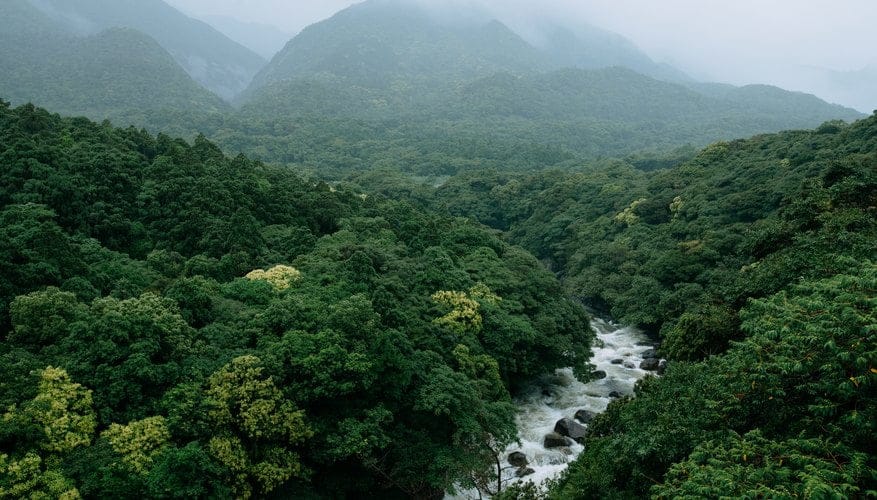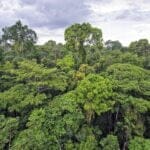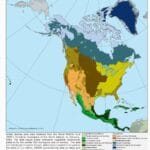Embark on a journey into the heart of two captivating forests: temperate and tropical rainforests. Dive into their enchanting realms, where towering trees dance amidst a symphony of life. Discover the secrets that make these forests both distinct and interconnected, playing critical roles in the balance of our planet.
Compare and Contrast Temperate and Tropical Rainforests
Imagine stepping into a world painted vibrant green, where the air hangs heavy with moisture and the chorus of life echoes through towering trees. This is the allure of rainforests – both temperate and tropical – but while they share a common name, their personalities are as diverse as the species they harbor.
Let’s start with where you might stumble upon these verdant wonderlands. Tropical rainforests, as their name suggests, are all about that tropical life. Picture locations like the Amazon basin, Central Africa, and Southeast Asia – areas kissed by the sun’s warmth year-round and drenched in frequent downpours. Temperate rainforests, on the other hand, prefer a more moderate climate. You’ll find them in cooler coastal areas, often draped across mountain slopes, in places like the Pacific Northwest of North America, southern Chile, and New Zealand. These forests experience distinct seasons, with cool, wet winters and milder summers.
Now, imagine the trees themselves. In a tropical rainforest, the trees reach for the sky, forming a dense canopy that blocks out much of the sunlight. These giants are often draped in vines and boast impressive buttress roots that snake out to provide extra support. The sheer variety of plant and animal life here is staggering, a dazzling display of biodiversity unmatched anywhere else on Earth. Scientists believe that tropical rainforests may hold more than half of the world’s plant and animal species, many yet to be discovered.
Temperate rainforests offer a different kind of beauty. While still impressive, the trees here tend to be shorter and more spread out, allowing dappled sunlight to reach the forest floor. You’ll find a mix of coniferous trees, like towering redwoods and Douglas firs, alongside broadleaf species like maples and oaks. The undergrowth is lush with ferns, mosses, and shrubs, creating a mystical, almost fairytale-like atmosphere. While not as biodiverse as their tropical cousins, temperate rainforests still boast a remarkable array of life, including unique species adapted to the cooler, wetter conditions.
Speaking of adaptations, both types of rainforests have their fair share. In the humid tropics, plants have evolved ways to shed excess water quickly, while some animals have developed bright colors and loud calls to stand out in the dim light. In temperate rainforests, many trees have thick bark to withstand the occasional cold snap, while animals often rely on camouflage to blend into the shadows.
But the importance of these forests goes far beyond their captivating beauty. Both temperate and tropical rainforests play a critical role in regulating our planet’s climate. They act as massive carbon sinks, absorbing vast amounts of carbon dioxide from the atmosphere. This helps to mitigate the effects of climate change, making their preservation all the more crucial.
Here’s a table summarizing some of the key differences between temperate and tropical rainforests:
| Feature | Temperate Rainforest | Tropical Rainforest |
|---|---|---|
| Location | Mid-latitude coastal and mountainous regions | Near the equator |
| Climate | Moderate temperatures, seasonal rainfall | Hot and humid year-round |
| Tree Types | Mix of coniferous and broadleaf trees | Predominantly broadleaf trees |
| Canopy | Less dense, allows some light through | Dense, blocking most sunlight |
| Biodiversity | High, but lower than tropical rainforests | Extremely high, highest on Earth |
Scientists are still unraveling the mysteries of these complex ecosystems. Ongoing research seeks to better understand the intricate relationships between species, the impacts of climate change, and the potential for sustainable management. Despite the challenges, one thing remains clear: preserving both temperate and tropical rainforests is crucial for the health of our planet and all its inhabitants.
Where Are Tropical and Temperate Rainforests Located?
Tropical rainforests, as you might guess from the name, are all about that tropical life! Imagine a steamy jungle, always warm and humid, where the sun beams down with serious intensity. That’s what it’s like near the equator, and that’s where you’ll find these incredible ecosystems thriving. Countries like Brazil, Indonesia, and the Democratic Republic of Congo, with their proximity to the equator, are practically synonymous with tropical rainforests.
Temperate rainforests, on the other hand, prefer a more laid-back vibe, hanging out in the cooler mid-latitudes. These forests can be found hugging coastlines or nestled in mountainous regions where the air is moist and rainfall is plentiful. Think of places like the Pacific Northwest of North America, parts of Chile, and even the southwestern coast of New Zealand – they all boast these beautiful temperate rainforests.
Here’s a simple way to remember the difference:
| Rainforest Type | Location | Climate |
|---|---|---|
| Tropical | Near the equator | Hot, humid, and rainy year-round |
| Temperate | Coastal and mountainous areas in mid-latitudes | Cooler, with distinct seasons and ample rainfall |
It’s important to remember that these are just general guidelines. There are always exceptions and variations within these broad categories. For example, elevation plays a big role, with some “tropical” rainforests found further from the equator at higher altitudes where temperatures are cooler.
Scientists are constantly studying the factors that influence where rainforests can exist, and with climate change already impacting our planet, understanding these ecosystems and their distribution becomes even more crucial. So, while we have a good grasp on the general locations of tropical and temperate rainforests, there’s still much to explore and learn about these fascinating and vital parts of our world!
What Is the Climate Like in Tropical vs. Temperate Rainforests?
Tropical rainforests are like the Earth’s saunas, consistently warm and damp throughout the year. They thrive in a narrow temperature band, rarely dipping below a balmy 20 degrees Celsius (68 degrees Fahrenheit), even at night. Rainfall is their lifeblood, a near-constant symphony of droplets that keeps the forest floor perpetually damp and teeming with life.
Venturing into a temperate rainforest is like experiencing the changing moods of nature itself. Located farther from the equator, in coastal and mountainous regions, they experience distinct seasons. Summers might be pleasantly warm and humid, but winters bring a noticeable chill, often accompanied by persistent drizzle. While rainfall is still plentiful, it follows a seasonal pattern, with some periods being wetter than others. This fluctuation creates a dynamic environment where plants and animals have adapted to cope with both abundance and scarcity of water. Interestingly, the canopy in temperate rainforests isn’t as dense as in their tropical counterparts, allowing dappled sunlight to reach the forest floor, fostering a different kind of plant diversity.
To better understand the contrasting climates, let’s take a look at this simple table:
| Feature | Tropical Rainforest | Temperate Rainforest |
|---|---|---|
| Location | Near the equator | Mid-latitudes, coastal/mountainous areas |
| Temperature | Consistently warm (rarely below 20°C) | Varies with seasons |
| Rainfall | High, year-round | High, but seasonal |
| Humidity | Very high | Moderate to high |
It’s important to remember that even within these two broad categories, there’s a spectrum of microclimates. Factors like altitude, proximity to the coast, and prevailing winds can create subtle variations in temperature and rainfall patterns. For instance, some scientists believe that “cloud forests,” a type of tropical rainforest found high in mountainous regions, may be particularly vulnerable to climate change due to their reliance on consistent cloud cover for moisture. Ongoing research continually deepens our understanding of these complex ecosystems and the myriad factors that influence their climates. So, the next time you find yourself lost in the verdant embrace of a rainforest, take a moment to appreciate the intricate interplay of climate and life that makes these ecosystems so remarkable.
How Does Biodiversity Differ Between These Forest Types?
Temperate and tropical rainforests, while both teeming with life, present strikingly different levels of biodiversity. Let’s explore the factors that contribute to these differences:
Temperate Rainforests: Adapting to Change
Temperate rainforests face the challenges of fluctuating temperatures and distinct seasons. This variability limits the types of species that can thrive there. However, life finds a way, and the organisms that inhabit these forests have developed remarkable adaptations to cope with these changes. Conifers, with their ability to withstand colder temperatures, are prominent, while deciduous trees lose their leaves in the fall to conserve water during the winter months. This mix of coniferous and deciduous trees contributes to the diversity of temperate rainforests, creating a mosaic of habitats that support a variety of plant and animal life.
Tropical Rainforests: A Biodiversity Hotspot
Tropical rainforests, with their consistently warm and humid climate, have provided a stable environment for life to flourish for millions of years. This stability, coupled with ample sunlight and rainfall, has led to an explosion of biodiversity, making them the most biodiverse terrestrial ecosystems on Earth. The lack of a distinct dry season allows for year-round plant growth, providing a constant source of food and shelter for a vast array of animals. From insects to primates, reptiles to amphibians, the tropical rainforest is a symphony of life, with each species playing a unique role in this intricate web of interactions.
Key Differences in Biodiversity:
- Temperate rainforests: Biodiversity is high but lower than tropical rainforests, influenced by seasonal changes and a mix of deciduous and coniferous trees.
- Tropical rainforests: Boast the highest biodiversity on Earth, driven by a stable, warm, and humid climate that supports year-round growth and a wider range of ecological niches.
Scientists are constantly discovering new species and uncovering the complexities of rainforest ecosystems. The differences in biodiversity between these two forest types highlight the profound influence of climate and evolutionary history on the distribution of life on our planet.
Explore the vast expanse of the amazon rainforest facts, home to an array of incredible creatures and astounding natural wonders. Discover 10 facts about the rainforest that will immerse you in the vibrant tapestry of life it supports. Delve into the captivating world of interesting facts deciduous forest, where the cycle of seasons paints a kaleidoscope of colors and biodiversity.
- Crypto Quotes’ Red Flags: Avoid Costly Mistakes - June 30, 2025
- Unlock Inspirational Crypto Quotes: Future Predictions - June 30, 2025
- Famous Bitcoin Quotes: A Deep Dive into Crypto’s History - June 30, 2025
















